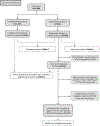Exome and genome sequencing in a heterogeneous population of patients with rare disease: Identifying predictors of a diagnosis
- PMID: 38436216
- PMCID: PMC11161308
- DOI: 10.1016/j.gim.2024.101115
Exome and genome sequencing in a heterogeneous population of patients with rare disease: Identifying predictors of a diagnosis
Abstract
Purpose: Exome (ES) and genome sequencing (GS) are increasingly being utilized for individuals with rare and undiagnosed diseases; however, guidelines on their use remain limited. This study aimed to identify factors associated with diagnosis by ES and/or GS in a heterogeneous population of patients with rare and undiagnosed diseases.
Methods: In this case control study, we reviewed data from 400 diagnosed and 400 undiagnosed randomly selected participants in the Undiagnosed Diseases Network, all of whom had undergone ES and/or GS. We analyzed factors associated with receiving a diagnosis by ES and/or GS.
Results: Factors associated with a decreased odds of being diagnosed included adult symptom onset, singleton sequencing, and having undergone ES and/or GS before acceptance to the Undiagnosed Diseases Network (48%, 51%, and 32% lower odds, respectively). Factors that increased the odds of being diagnosed by ES and/or GS included having primarily neurological symptoms and having undergone prior chromosomal microarray testing (44% and 59% higher odds, respectively).
Conclusion: We identified several factors that were associated with receiving a diagnosis by ES and/or GS. This will ideally inform the utilization of ES and/or GS and help manage expectations of individuals and families undergoing these tests.
Keywords: Exome sequencing; Genome sequencing; Predictors of a diagnosis; Rare disease; Undiagnosed disease.
Copyright © 2024 American College of Medical Genetics and Genomics. Published by Elsevier Inc. All rights reserved.
Conflict of interest statement
Conflict of Interest The authors declare no conflicts of interest.
Figures
Similar articles
-
Limitations of exome sequencing in detecting rare and undiagnosed diseases.Am J Med Genet A. 2020 Jun;182(6):1400-1406. doi: 10.1002/ajmg.a.61558. Epub 2020 Mar 19. Am J Med Genet A. 2020. PMID: 32190976 Free PMC article.
-
Diagnostic yield of exome and genome sequencing after non-diagnostic multi-gene panels in patients with single-system diseases.Orphanet J Rare Dis. 2024 May 24;19(1):216. doi: 10.1186/s13023-024-03213-x. Orphanet J Rare Dis. 2024. PMID: 38790019 Free PMC article.
-
Exome/Genome Sequencing in Undiagnosed Syndromes.Annu Rev Med. 2023 Jan 27;74:489-502. doi: 10.1146/annurev-med-042921-110721. Annu Rev Med. 2023. PMID: 36706750 Free PMC article. Review.
-
Case for genome sequencing in infants and children with rare, undiagnosed or genetic diseases.J Med Genet. 2019 Dec;56(12):783-791. doi: 10.1136/jmedgenet-2019-106111. Epub 2019 Apr 25. J Med Genet. 2019. PMID: 31023718 Free PMC article. Review.
-
Narrowing the diagnostic gap: Genomes, episignatures, long-read sequencing, and health economic analyses in an exome-negative intellectual disability cohort.Genet Med. 2024 May;26(5):101076. doi: 10.1016/j.gim.2024.101076. Epub 2024 Jan 19. Genet Med. 2024. PMID: 38258669 Free PMC article.
References
-
- Haendel M, Vasilevsky N, Unni D, Bologa C, Harris N, Rehm H, Hamosh A, Baynam G, Groza T, McMurry J, Dawkins H, Rath A, Thaxon C, Bocci G, Joachimiak MP, Köhler S, Robinson PN, Mungall C, & Oprea TI (2020). How many rare diseases are there? Nature Reviews Drug Discovery, 19(2), 77–78. 10.1038/d41573-019-00180-y - DOI - PMC - PubMed
-
- Spillmann RC, McConkie-Rosell A, Pena L, Jiang Y-H, Adams CJ, Adams DR, Alejandro ME, Allard P, Ashley EA, Azamian MS, Bacino CA, Balasubramanyam A, Barseghyan H, Beggs AH, Bellen HJ, Bernstein JA, Bican A, Bick DP, Birch CL, … Undiagnosed Diseases Network. (2017). A window into living with an undiagnosed disease: Illness narratives from the Undiagnosed Diseases Network. Orphanet Journal of Rare Diseases, 12(1), 71. 10.1186/s13023-017-0623-3 - DOI - PMC - PubMed
Publication types
MeSH terms
Grants and funding
LinkOut - more resources
Full Text Sources
Medical
Molecular Biology Databases


